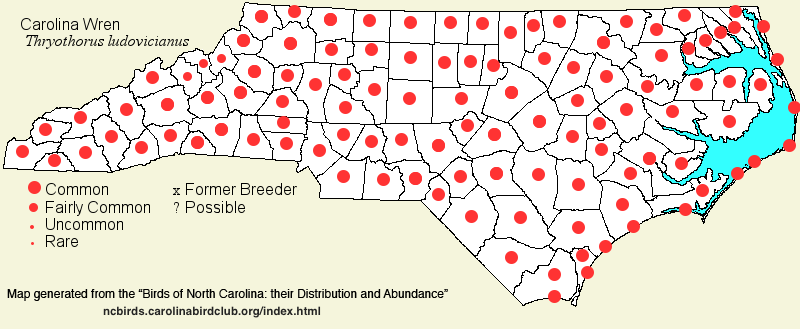 |  |
|
Carolina Wren - Thryothorus ludovicianus TROGLODYTIDAE Members: | Search Common: Search Scientific: |
|
|
|||||||
| General Comments | The Carolina Wren, the state bird of South Carolina, is one of the better known birds in North Carolina, as it is one of the few that sings all year, occurs in residential areas, and is a common and conspicuous (for a wren) bird. It is quite inquisitive, nesting in nooks and crannies in buildings and other odd places; in the "wild", nests are built most often near the base of a tree or in a cranny along a stream bank. It is completely nonmigratory and occurs in all areas of the state. Habitats are very widespread in forested or semi-forested areas, but they usually favor dense tangles or shrub/sapling layers (evergreen in winter), such as beneath a canopy of pine or mixed woods. They also occur in wooded residential areas, as long as there are dense/evergreen shrubs present. | ||||||
| Breeding Status | Breeder | ||||||
| NC BRC List | Definitive | ||||||
| State Status | |||||||
| U.S. Status | |||||||
| State Rank | S5 | ||||||
| Global Rank | G5 | ||||||
| Coastal Plain | Permanent resident; nonmigratory. Common to very common across the entire region, even on barrier islands, as long as there are shrub thickets. Peak counts: | ||||||
| Piedmont | Permanent resident; nonmigratory. Common to very common over the entire province. Numbers can be depressed slightly during and after severe winters or heavy snowfalls, though still relatively common. Peak counts: | ||||||
| Mountains | Permanent resident; nonmigratory. Common over the province up to about 4,500 feet, and sparingly up to about 5,000 feet; can wander after breeding to higher elevations. Numbers are often depressed after severe winter weather, though even so, at least fairly common. Peak counts: | ||||||
| Finding Tips |
None needed. **** | ||||||
| Attribution | LeGrand[2023-03-27], LeGrand[2012-09-16], LeGrand[2011-12-11] | ||||||
| NC Map Map depicts all counties with a report (transient or resident) for the species. | Click on county for list of all known species. |
| NC Breeding Season Map Map depicts assumed breeding season abundance for the species. |  |